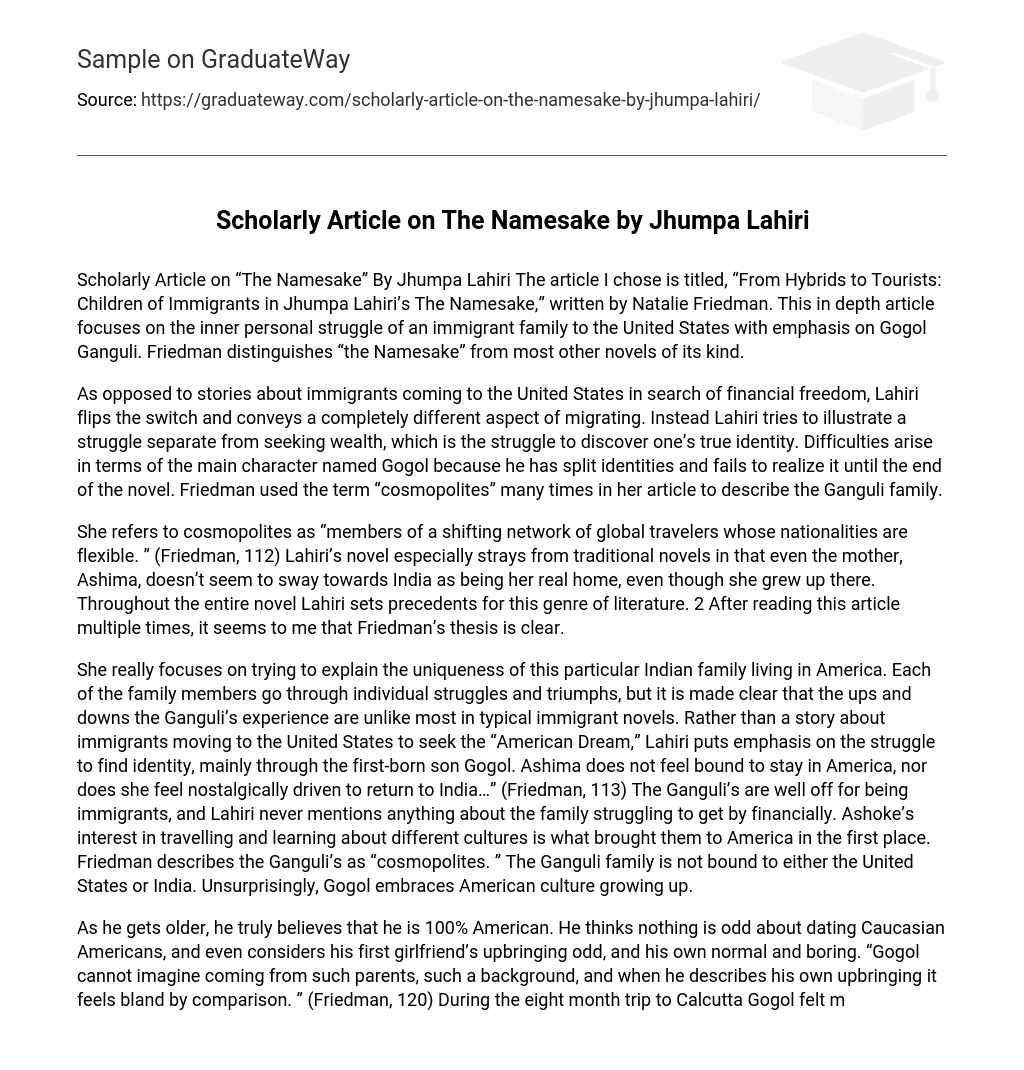Scholarly Article on “The Namesake” By Jhumpa Lahiri The article I chose is titled, “From Hybrids to Tourists: Children of Immigrants in Jhumpa Lahiri’s The Namesake,” written by Natalie Friedman. This in depth article focuses on the inner personal struggle of an immigrant family to the United States with emphasis on Gogol Ganguli. Friedman distinguishes “the Namesake” from most other novels of its kind.
As opposed to stories about immigrants coming to the United States in search of financial freedom, Lahiri flips the switch and conveys a completely different aspect of migrating. Instead Lahiri tries to illustrate a struggle separate from seeking wealth, which is the struggle to discover one’s true identity. Difficulties arise in terms of the main character named Gogol because he has split identities and fails to realize it until the end of the novel. Friedman used the term “cosmopolites” many times in her article to describe the Ganguli family.
She refers to cosmopolites as “members of a shifting network of global travelers whose nationalities are flexible. ” (Friedman, 112) Lahiri’s novel especially strays from traditional novels in that even the mother, Ashima, doesn’t seem to sway towards India as being her real home, even though she grew up there. Throughout the entire novel Lahiri sets precedents for this genre of literature. 2 After reading this article multiple times, it seems to me that Friedman’s thesis is clear.
She really focuses on trying to explain the uniqueness of this particular Indian family living in America. Each of the family members go through individual struggles and triumphs, but it is made clear that the ups and downs the Ganguli’s experience are unlike most in typical immigrant novels. Rather than a story about immigrants moving to the United States to seek the “American Dream,” Lahiri puts emphasis on the struggle to find identity, mainly through the first-born son Gogol. Ashima does not feel bound to stay in America, nor does she feel nostalgically driven to return to India…” (Friedman, 113) The Ganguli’s are well off for being immigrants, and Lahiri never mentions anything about the family struggling to get by financially. Ashoke’s interest in travelling and learning about different cultures is what brought them to America in the first place. Friedman describes the Ganguli’s as “cosmopolites. ” The Ganguli family is not bound to either the United States or India. Unsurprisingly, Gogol embraces American culture growing up.
As he gets older, he truly believes that he is 100% American. He thinks nothing is odd about dating Caucasian Americans, and even considers his first girlfriend’s upbringing odd, and his own normal and boring. “Gogol cannot imagine coming from such parents, such a background, and when he describes his own upbringing it feels bland by comparison. ” (Friedman, 120) During the eight month trip to Calcutta Gogol felt more like a tourist than a native. Once again he was 3 thrown into a culture that he knew was part of him, but at the times was still dormant deep inside of him. He would trade in the Taj Mahal for the relief he finds when he returns home to his cupboards filled with familiar labels: Skippy, Hood, Bumble Bee, Land O’ Lakes. ” (Lahiri, 87) At that time, the simple comforts of home in America were more important to Gogol than beauty such as the Taj Mahal. Ironically enough, seeing the Taj Mahal while in India sparked the interest that led to his career as an architect. Gogol was so confused about his identity by the time he became involved with his second Caucasian American, Maxine.
He was so entrenched in American culture, that the only difference he saw between He and Maxine at first was class. It wasn’t until Gogol’s father’s passing that he realized how he had been neglecting his parents and their born Indian culture. Another interesting part to the article is the use of the word hybrid. Multiple experiences in Gogol’s life kept him bouncing back and forth between being an American and being independent from his parents, to running back to his home to Indian culture.
In this case, hybridity is Gogol doing exactly that. Part of him is Indian and part of him is American. He can’t decide in his heart where his true loyalty lies. Natalie Friedman’s article breaks down arguably the most difficult part to understand in Jhumpa Lahiri’s “The Namesake. ” It takes a lot of thought to get down to the core of what it’s like to be immigrants adjusting to life in America, as well as the children that grow up with a completely different culture than the parents.
The constant battle in your head about who you really are can get very intricate. I 4 completely agree with the approach Friedman took, and I was able to completely understand her break down of the novel. I liked how she used quotes from other immigrant authors’ work to put Lahiri’s into perspective. Friedman contrasted Gogol and Moushoumi’s stories in the article for readers to understand how they were so alike, but in other ways very different. I believe that Friedman left out one important underlying detail of the novel.
She never mentioned anything about the significance that trains had on the Ganguli family. I believe that part is very significant because the trip that Ashoke made in the beginning defines the rest of the novel. The last few pages of the novel were put together well because in them, it finally hits Gogol who he really is, and for once in his life, he is content. Works Cited Friedman, Natalie. “From Hybrids to Tourists: Children of Immigrants in Jhumpa Lahiri’s The Namesake. ” (2008): 111-124. Lahiri, Jhumpa. The Namesake. New York: 2003. 1-289.





